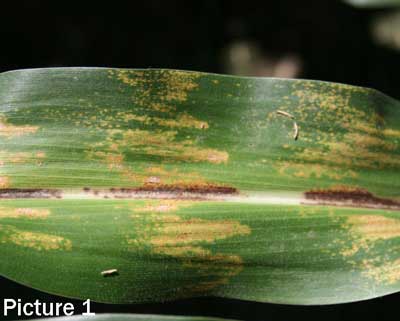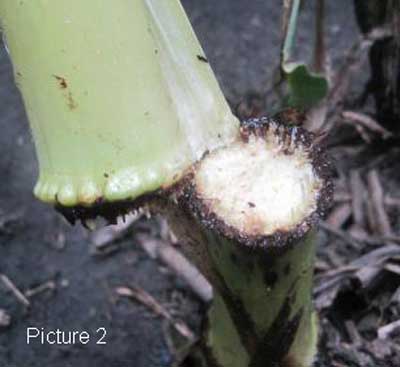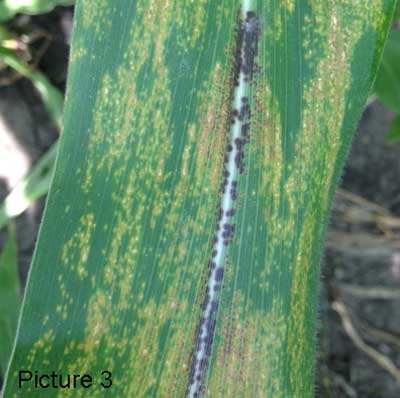
- Physoderma brown spot (Physoderma maydis) can survive in the soil and crop residue for up to 7 years.
- Severe outbreaks of Physoderma have been associated with stalk rot and breakage.
- Symptoms can be confused with eyespot, common or southern rust.
- Management includes the reduction of P. maydis inoculum through tillage and crop rotation.
Biology and Life Cycle
Physoderma brown spot is caused by the fungus-like organism Physoderma maydis. The pathogen produces brown sporangia, which are embedded in host tissues, most noticeably in foliage. Sporangia are structures that allow the organism to survive and overwinter. Under the proper conditions, typically humid and extremely wet conditions early in the growing season, sporangia germinate and release numerous zoospores. Zoospores can move in water and may be rain-splashed into the developing plant. Water held behind the whorl or leaf sheaths creates a favorable environment for Physoderma, and allows the zoospores ample opportunity to infect tissues. Once affected, stalks may develop a basal stalk rot, whereas foliage may develop small, yellow to purple spots along the leaf veins. After harvest, the pathogen is returned to the crop surface as infested residue, where it can overwinter for up to 7 years. Physoderma brown spot may be more common in continuous corn, and under conservation tillage.
Physoderma is normally a minor disease of corn and the leaf blight phase of the infection rarely affects yields, although some parts of the Midwest have reported an increase of this disease in recent years. In the past, severe outbreaks of this disease have been associated with corn lodging. Infection at lower stalk nodes causes stalks to become weakened and subject to snapping. Extremely wet weather appears to be a causal factor of Physoderma stalk rot and breakage.
Symptoms
Symptoms first appear as very small, oblong to round, yellowish spots on leaf blades, leaf sheath, stalk, and sometimes on the outer ear husks and tassels. Because light is required to infect corn plants, leaf symptoms may appear in alternating bands of infected and non-infected tissue (Pic. 1). Infected tissues turn chocolate brown to reddish brown and coalesce to form large, irregular, angular blotches. Cells of infected tissues disintegrate and expose pustules containing large numbers of golden brown to dark brown sporangia. Stalks infected at the nodes beneath the leaf sheaths frequently break (Pic. 2).
Symptoms of Physoderma can be misdiagnosed as eyespot, common rust and southern rust, all more serious diseases of corn. However, the spots of Physoderma do not have the light colored center that is associated with eyespot. Furthermore, unlike lesions caused by Physoderma, pustules associated with rust can be wiped off of the upper leaf surface with your finger. Keep in mind that rusts typically will appear later in the season, whereas Physoderma infections will occur between V5-V9. Additionally, one of the key characteristics to differentiate Physoderma from these other disease is that the lesions for Physoderma develop in distinct bands across the leaf. These lesions tend to be darker in color along the midrib than on the remainder of the leaf blade which is a clue to the identity of the disease (Pic. 3).

Late-season symptom differentiation and decision making: In situations where you have two or more diseases on the same plant, producing similar symptoms, it can become challenging to tell them apart. Late in the season as corn plants mature long after initial disease infection, sending samples to a diagnostic lab will provide the most accurate diagnosis. The practical question that you need to ask yourself is whether there is something you can do this late in the season to protect your crop. Most diseases should be managed preventively, so field scouting early in the season will be more effective in a) diagnosing symptoms and b) making management decisions.
My opinion is that even when it's too late to do anything, it is important to know what diseases were present in the field this year to make management decisions for next year. You also should check affected fields for lodging potential. To do this, I suggest scouting one spot per 10-20 acres of field. At each spot push 30 plants over 100-200 linear feet , recording the number of plants that do not return to a standing position. A good "push" typically will move the plant 30-45° from the vertical, which can be achieved by pushing at the base of the ear until your arm is fully extended. Fields with greater than 10-15% lodging should be the first fields harvested.
Management
Since the fungus survives in the soil and crop residue for 2 to 7 years, management of Physoderma brown spot includes reduction of inoculum through tillage and crop rotation practices. Although some fungicides list Physoderma brown spot on their label, there is no data available on application timing and their impacts on Physoderma severity. Some hybrids appear to be more susceptible to infection by Physoderma than others. Consult your local FS Crop Specialist for more information on Physoderma identification and management.
Picture 1: Characteristic symptoms of Physoderma brown spot infection. Note the alternating band pattern of infected and non-infected tissue. (Source: GROWMARK, Inc.)
Picture 2: Stalk rot and breakage caused by Physoderma infection. (Source: Alison Robertson- Iowa State University).
Picture 3: Darker color lesions found on the midrib of the leaf; a key symptom of Physoderma brown spot infection. (source: GROWMARK, Inc.)
